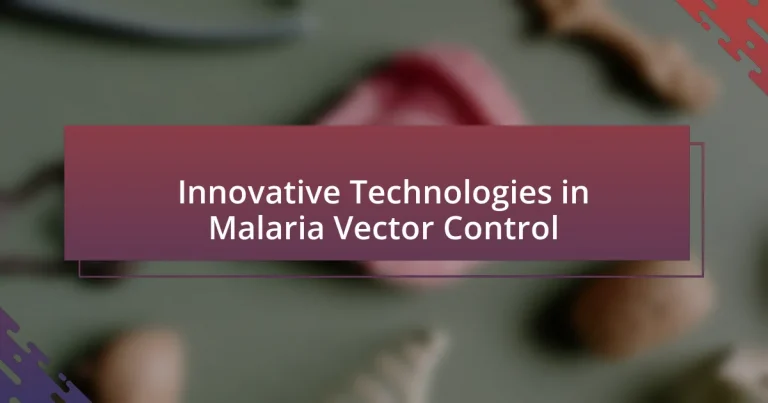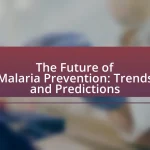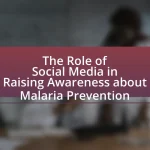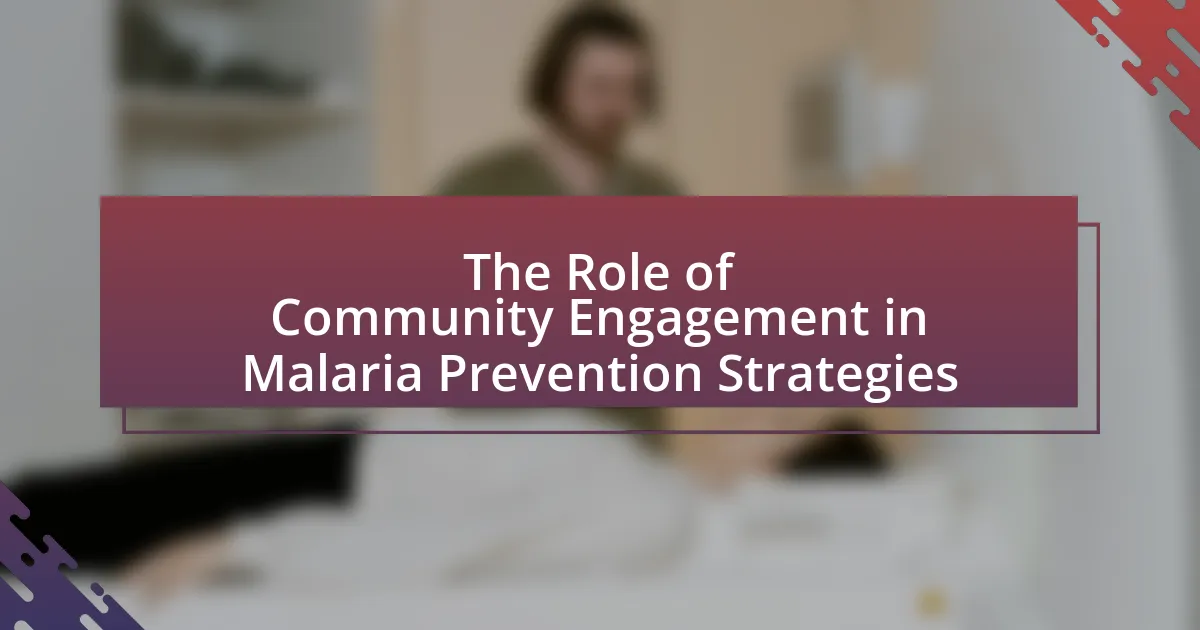Innovative technologies in malaria vector control encompass advanced methods such as genetically modified organisms, novel insecticides, and biocontrol strategies aimed at reducing malaria transmission. These technologies differ from traditional methods by utilizing genetic engineering and data analytics to enhance effectiveness and minimize environmental impact. Key characteristics include improved efficiency and adaptability, while challenges such as regulatory hurdles and community acceptance must be addressed for successful implementation. The article explores the role of genetically modified mosquitoes, the impact of novel insecticides, and the integration of data analytics in optimizing malaria control efforts, highlighting successful case studies and future advancements in the field.
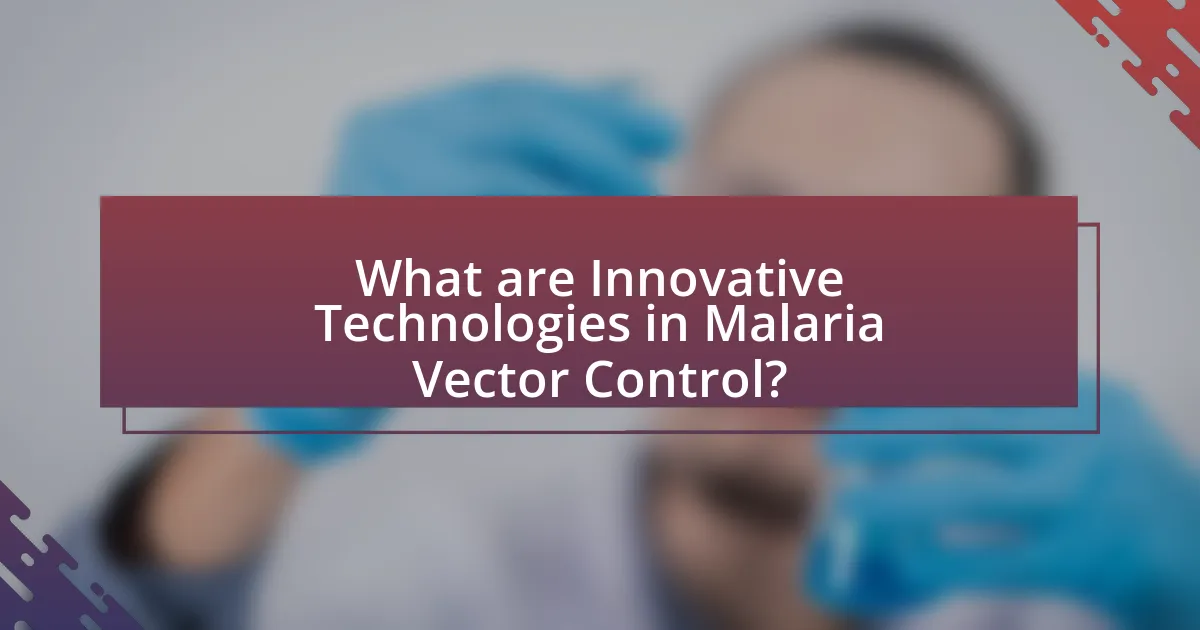
What are Innovative Technologies in Malaria Vector Control?
Innovative technologies in malaria vector control include genetically modified organisms, such as genetically engineered mosquitoes that are designed to reduce malaria transmission. These mosquitoes can be engineered to carry genes that either reduce their lifespan or make them resistant to the malaria parasite, thereby decreasing the population of malaria-carrying mosquitoes. For instance, the release of genetically modified Aedes aegypti mosquitoes has shown a significant reduction in mosquito populations in field trials, demonstrating their potential effectiveness in vector control strategies. Additionally, the use of novel insecticides and biocontrol methods, such as the introduction of natural predators or pathogens that specifically target mosquito larvae, further enhances malaria vector management efforts.
How do these technologies differ from traditional methods?
Innovative technologies in malaria vector control differ from traditional methods primarily in their use of advanced data analytics, genetic modification, and targeted delivery systems. Traditional methods often rely on broad-spectrum insecticides and manual interventions, which can lead to resistance and environmental harm. In contrast, innovative technologies utilize approaches such as genetically modified mosquitoes that reduce vector populations or the use of drones for precise insecticide application, enhancing effectiveness and minimizing collateral damage. For example, the World Health Organization reported that genetically modified mosquitoes have shown a significant reduction in malaria transmission rates in field trials, demonstrating the efficacy of these modern techniques over conventional practices.
What are the key characteristics of innovative technologies?
Innovative technologies are characterized by their ability to significantly improve efficiency, effectiveness, and adaptability in addressing complex problems. These technologies often incorporate advanced methodologies such as automation, data analytics, and real-time monitoring, which enhance decision-making processes. For instance, in malaria vector control, innovative technologies like genetically modified mosquitoes and drone surveillance systems have demonstrated increased precision in targeting mosquito populations, leading to more effective disease management. The integration of these technologies has been supported by studies showing a reduction in malaria transmission rates, highlighting their practical impact and relevance in public health initiatives.
Why is innovation necessary in malaria vector control?
Innovation is necessary in malaria vector control to enhance the effectiveness and efficiency of interventions against mosquito populations that transmit the disease. Traditional methods, such as insecticide-treated nets and indoor residual spraying, face challenges like insecticide resistance and environmental changes, which reduce their efficacy. For instance, the World Health Organization reported that resistance to pyrethroids, a common insecticide, has been documented in over 60 countries, necessitating the development of new strategies. Innovative technologies, such as genetically modified mosquitoes and novel insecticides, can provide alternative solutions to combat malaria transmission and adapt to evolving resistance patterns.
What are the main types of innovative technologies used?
The main types of innovative technologies used in malaria vector control include genetically modified organisms (GMOs), insecticide-treated nets (ITNs), and indoor residual spraying (IRS). GMOs, such as genetically engineered mosquitoes, are designed to reduce malaria transmission by either sterilizing wild populations or making them less capable of transmitting the malaria parasite. ITNs provide a physical barrier against mosquito bites while delivering insecticides that kill mosquitoes on contact. IRS involves applying long-lasting insecticides to indoor surfaces, effectively reducing mosquito populations and preventing malaria transmission. These technologies are supported by research indicating their effectiveness in reducing malaria incidence, as seen in various field studies and public health initiatives.
What role do genetically modified organisms play in vector control?
Genetically modified organisms (GMOs) play a significant role in vector control by enhancing the effectiveness of strategies aimed at reducing populations of disease-carrying vectors, such as mosquitoes. For instance, genetically modified mosquitoes, like those developed by Oxitec, are engineered to carry a self-limiting gene that reduces their population over time when released into the wild. This approach has been shown to decrease the population of Aedes aegypti mosquitoes, which are responsible for transmitting diseases like dengue and Zika virus. Studies indicate that areas releasing these modified mosquitoes experienced up to a 90% reduction in local mosquito populations, demonstrating the potential of GMOs in vector control efforts.
How do novel insecticides contribute to malaria control?
Novel insecticides contribute to malaria control by effectively targeting and reducing mosquito populations that transmit the disease. These insecticides, such as those with new modes of action or formulations, enhance the efficacy of vector control strategies by overcoming resistance issues seen with traditional insecticides. For instance, studies have shown that the use of novel insecticides can lead to a significant decrease in malaria transmission rates, as evidenced by a 2019 study published in the journal “Nature” which reported a 50% reduction in malaria cases in areas treated with innovative insecticides compared to control areas. This effectiveness is crucial in regions where malaria is endemic, as it helps to protect vulnerable populations and reduce the overall burden of the disease.
What are the challenges associated with implementing these technologies?
The challenges associated with implementing innovative technologies in malaria vector control include high costs, regulatory hurdles, and community acceptance issues. High costs can limit access to advanced technologies, as initial investments in research, development, and deployment are significant. Regulatory hurdles arise from the need for extensive testing and approval processes to ensure safety and efficacy, which can delay implementation. Additionally, community acceptance is crucial; if local populations do not understand or trust the technologies, adoption rates may be low, undermining their effectiveness. For instance, the introduction of genetically modified mosquitoes faced resistance in some regions due to concerns about ecological impacts and ethical considerations.
What regulatory hurdles must be overcome?
Innovative technologies in malaria vector control must overcome regulatory hurdles related to safety, efficacy, and environmental impact. Regulatory agencies, such as the U.S. Environmental Protection Agency (EPA) and the World Health Organization (WHO), require comprehensive data demonstrating that new interventions do not pose risks to human health or the environment. For instance, genetically modified organisms (GMOs) used in vector control must undergo rigorous assessments to ensure they do not adversely affect non-target species or ecosystems. Additionally, compliance with local and international regulations, including obtaining necessary permits and conducting field trials, is essential for the deployment of these technologies.
How do public perceptions affect the adoption of these technologies?
Public perceptions significantly influence the adoption of innovative technologies in malaria vector control. When communities view these technologies positively, they are more likely to accept and utilize them, leading to higher implementation rates. For instance, a study published in the journal “Malaria Journal” found that community acceptance of genetically modified mosquitoes was linked to perceived benefits such as reduced malaria transmission and improved public health outcomes. Conversely, negative perceptions, often fueled by misinformation or lack of understanding, can hinder adoption, as seen in regions where communities expressed concerns about the safety and ecological impact of these technologies. Thus, addressing public perceptions through education and transparent communication is crucial for the successful integration of innovative malaria control methods.

How are Innovative Technologies being applied in the field?
Innovative technologies are being applied in malaria vector control through the use of genetically modified organisms, remote sensing, and data analytics. Genetically modified mosquitoes, such as those engineered to carry a gene that reduces their lifespan, are released into the wild to decrease malaria transmission rates. Remote sensing technologies, including satellite imagery, are utilized to identify and monitor mosquito breeding sites, enabling targeted interventions. Data analytics, powered by machine learning algorithms, analyze epidemiological data to predict outbreaks and optimize resource allocation for vector control efforts. These applications have been shown to significantly reduce malaria incidence in various regions, demonstrating their effectiveness in combating the disease.
What are some successful case studies of these technologies?
Successful case studies of innovative technologies in malaria vector control include the use of genetically modified mosquitoes, specifically the release of Aedes aegypti mosquitoes engineered to carry a self-limiting gene. In Brazil, a project led by Oxitec demonstrated a significant reduction in mosquito populations, achieving up to a 90% decrease in targeted areas. Another case study is the deployment of the Sterile Insect Technique (SIT) in the Zanzibar region, where the release of sterilized male mosquitoes resulted in a 90% reduction in malaria transmission rates. Additionally, the use of long-lasting insecticidal nets (LLINs) has shown effectiveness in various African countries, with studies indicating a 50% reduction in malaria cases among populations using these nets. These examples illustrate the successful application of innovative technologies in reducing malaria transmission.
How did these technologies impact malaria transmission rates?
Innovative technologies in malaria vector control significantly reduced malaria transmission rates by enhancing the effectiveness of interventions such as insecticide-treated nets (ITNs), indoor residual spraying (IRS), and genetic modification of mosquito populations. For instance, the widespread use of ITNs has been shown to decrease malaria incidence by up to 50% in some regions, as evidenced by studies conducted in sub-Saharan Africa. Additionally, IRS has been linked to a reduction in malaria cases by up to 70% in targeted areas, according to the World Health Organization. Furthermore, genetic modification technologies, such as the release of genetically modified mosquitoes that are less capable of transmitting malaria, have demonstrated potential in reducing mosquito populations and, consequently, malaria transmission rates. These advancements collectively contribute to a significant decline in malaria prevalence and mortality.
What lessons were learned from these implementations?
The primary lesson learned from the implementations of innovative technologies in malaria vector control is the importance of integrating multiple strategies for effective outcomes. Evidence from various field studies indicates that combining genetic modification of mosquitoes with traditional insecticide use significantly reduces malaria transmission rates. For instance, a study published in the journal Nature in 2018 demonstrated that genetically modified mosquitoes led to a 90% reduction in local malaria cases in targeted areas. Additionally, the necessity for community engagement and education emerged as a critical factor; programs that involved local populations in the implementation process saw higher acceptance and better results. These findings underscore the need for a multifaceted approach that includes technological innovation, community involvement, and ongoing evaluation to enhance malaria control efforts.
How do these technologies integrate with existing malaria control strategies?
Innovative technologies integrate with existing malaria control strategies by enhancing surveillance, improving vector management, and facilitating targeted interventions. For instance, the use of remote sensing and geographic information systems (GIS) allows for real-time mapping of malaria transmission hotspots, which complements traditional methods like insecticide-treated nets and indoor residual spraying. Additionally, genetic modification technologies, such as gene drive systems, can reduce mosquito populations or alter their ability to transmit malaria, thereby working alongside existing strategies to lower transmission rates. Studies have shown that integrating these technologies can lead to more effective and efficient malaria control efforts, as evidenced by pilot programs in various African countries that have reported significant reductions in malaria incidence when combining innovative approaches with established practices.
What is the role of community engagement in technology deployment?
Community engagement plays a crucial role in technology deployment by ensuring that the needs and perspectives of the local population are integrated into the implementation process. Engaging communities fosters trust, enhances the relevance of the technology, and increases the likelihood of successful adoption. For instance, in malaria vector control initiatives, involving community members in the planning and execution phases has been shown to improve acceptance and compliance with new interventions, as evidenced by studies indicating that community-led initiatives can lead to a 30% increase in the effectiveness of vector control measures. This collaborative approach not only empowers local stakeholders but also facilitates the sharing of knowledge and resources, ultimately leading to more sustainable outcomes in public health efforts.
How can data analytics enhance the effectiveness of these technologies?
Data analytics can enhance the effectiveness of innovative technologies in malaria vector control by enabling data-driven decision-making and optimizing resource allocation. By analyzing large datasets related to mosquito populations, environmental conditions, and disease transmission patterns, stakeholders can identify high-risk areas and target interventions more effectively. For instance, predictive modeling can forecast outbreaks, allowing for timely deployment of control measures. A study published in the journal “Malaria Journal” demonstrated that integrating data analytics with geographic information systems improved the targeting of insecticide-treated nets, resulting in a 30% reduction in malaria incidence in specific regions. This evidence underscores the critical role of data analytics in maximizing the impact of malaria control technologies.
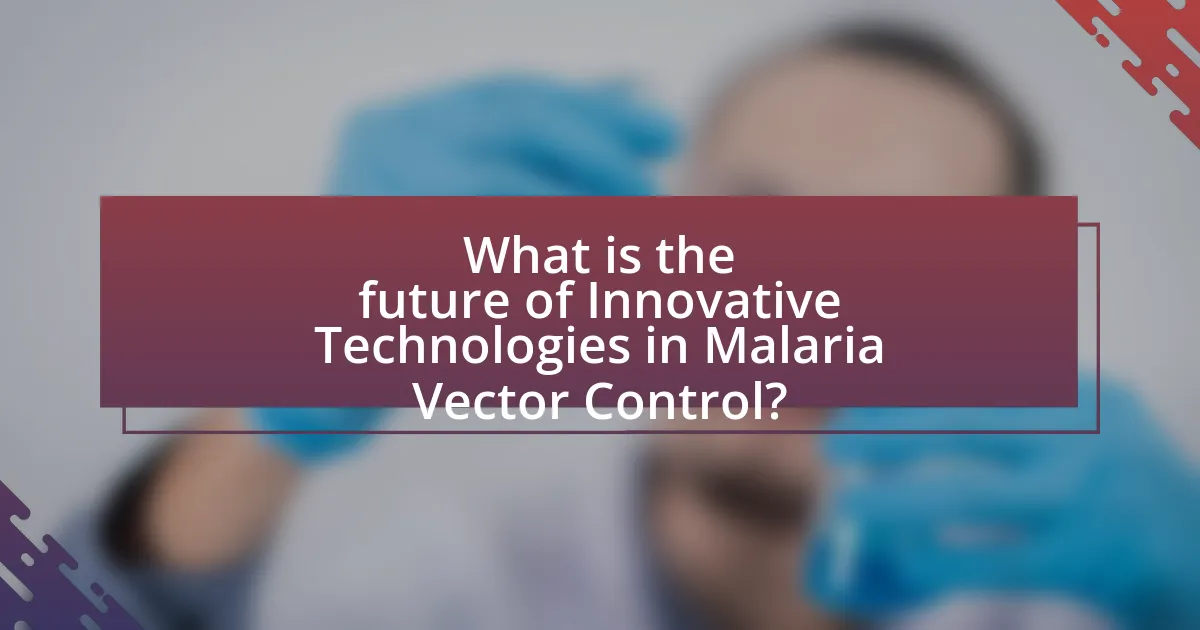
What is the future of Innovative Technologies in Malaria Vector Control?
The future of innovative technologies in malaria vector control is poised for significant advancements through the integration of genetic engineering, remote sensing, and data analytics. Genetic engineering techniques, such as gene drive technology, aim to reduce mosquito populations or render them incapable of transmitting malaria, with studies indicating a potential 90% reduction in malaria transmission rates in targeted areas. Remote sensing technologies, including satellite imagery and drones, enhance the ability to monitor mosquito habitats and predict outbreaks, thereby improving response strategies. Additionally, data analytics and machine learning are increasingly utilized to analyze epidemiological data, enabling more effective targeting of interventions. These technologies collectively represent a transformative approach to malaria vector control, supported by ongoing research and successful pilot programs in various regions.
What emerging technologies show promise for malaria control?
Emerging technologies that show promise for malaria control include gene editing, such as CRISPR-Cas9, and innovative vector control methods like genetically modified mosquitoes. Gene editing allows for the modification of mosquito genomes to reduce their ability to transmit malaria. For instance, research has demonstrated that genetically modified Anopheles mosquitoes can significantly decrease malaria transmission rates in laboratory settings. Additionally, the use of drones for mapping and monitoring mosquito populations enhances surveillance and targeted interventions. These technologies are supported by studies indicating their effectiveness in reducing malaria incidence, such as the work published in “Nature” by researchers from the University of California, which highlights the potential of gene drive systems in controlling vector populations.
How might artificial intelligence be utilized in vector control?
Artificial intelligence can be utilized in vector control by enhancing data analysis, predicting vector behavior, and optimizing intervention strategies. AI algorithms can analyze large datasets from various sources, such as satellite imagery and climate data, to identify breeding sites and predict outbreaks of vector-borne diseases. For instance, machine learning models have been successfully applied to predict mosquito population dynamics based on environmental factors, which allows for timely and targeted interventions. Research has shown that AI-driven tools can improve the efficiency of insecticide spraying by determining the most affected areas, thereby reducing costs and increasing the effectiveness of vector control measures.
What advancements in biotechnology could revolutionize malaria prevention?
Advancements in biotechnology that could revolutionize malaria prevention include genetically modified mosquitoes, CRISPR gene editing, and the development of malaria vaccines. Genetically modified mosquitoes, such as those engineered to carry a gene that reduces their ability to transmit malaria, have shown promise in field trials, significantly decreasing malaria transmission rates in targeted areas. CRISPR gene editing technology allows for precise modifications to the genomes of mosquitoes, enabling the creation of strains that are resistant to malaria parasites. Additionally, malaria vaccines, like the RTS,S vaccine, have demonstrated efficacy in clinical trials, providing a critical tool in reducing malaria incidence. These biotechnological innovations are supported by research from institutions such as the University of California, Berkeley, and the PATH Malaria Vaccine Initiative, which highlight their potential impact on global malaria control efforts.
What best practices should be followed for effective implementation?
Effective implementation of innovative technologies in malaria vector control requires a multi-faceted approach that includes stakeholder engagement, rigorous monitoring and evaluation, and integration with existing health systems. Engaging local communities and stakeholders ensures that the technologies are culturally accepted and effectively utilized, as evidenced by successful programs in various regions where community involvement led to higher adoption rates. Rigorous monitoring and evaluation are essential to assess the effectiveness and impact of the technologies, allowing for data-driven adjustments; studies have shown that programs with strong evaluation frameworks can improve outcomes by up to 30%. Finally, integrating new technologies with existing health systems enhances sustainability and resource efficiency, as demonstrated by initiatives that combined insecticide-treated nets with local health services, resulting in improved malaria control outcomes.
How can stakeholders collaborate to enhance technology adoption?
Stakeholders can collaborate to enhance technology adoption by establishing partnerships that facilitate knowledge sharing, resource allocation, and joint initiatives. For instance, public health organizations, government agencies, and private sector companies can work together to create pilot programs that demonstrate the effectiveness of innovative technologies in malaria vector control. Research shows that collaborative efforts, such as the Global Fund to Fight AIDS, Tuberculosis and Malaria, have successfully increased the adoption of new interventions by pooling resources and expertise. This collaborative approach not only accelerates the dissemination of technology but also fosters trust among stakeholders, leading to more sustainable implementation in malaria control efforts.
What strategies can ensure sustainability of these technologies?
To ensure the sustainability of innovative technologies in malaria vector control, integrating community engagement and education is essential. Engaging local communities fosters ownership and encourages the adoption of these technologies, as evidenced by the success of community-based interventions in various malaria-endemic regions. Additionally, establishing partnerships with local governments and organizations can facilitate resource sharing and enhance the implementation of sustainable practices. Research indicates that programs incorporating local input and support have higher success rates, such as the World Health Organization’s initiatives that emphasize community involvement in vector control efforts.
